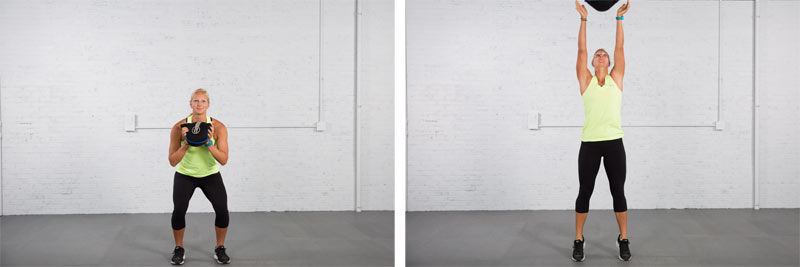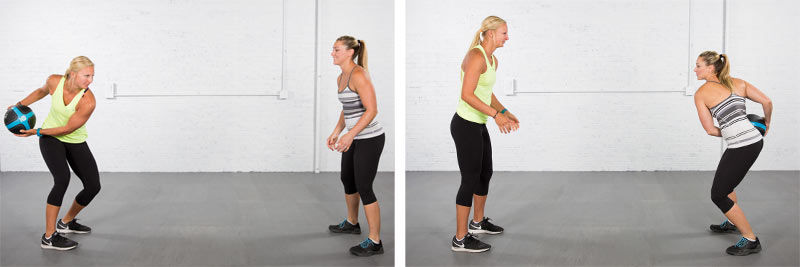The term plyometrics is usually used to refer to explosive lower-body exercises such as skips, hops, jumps and bounds. However, plyometric training is also important for the upper body as well. According to the principle of specificity, muscles adapt to how they are trained. Therefore, doing jumps can improve lower-body power, but it will not have any affect on the muscles of the upper body. If the goal is to help improve upper-body power for activities like swinging a racquet, bat or club, or simply to have more strength to handle common tasks like picking up a child or carrying a heavy bag, then it can be important to do plyometric training specifically for the upper body.
Plyometric training was originally called “shock training” by the Soviet sport scientists who developed the technique. Plyometric training works by initiating a rapid contraction of the muscle fibers, which places tension on the elastic connective tissue. The faster the elastic tissue lengthens, the faster and more explosively it can shorten, which leads to higher levels of muscle power output.
When starting a plyometric training program, whether for upper- or lower-body muscles, it is important to start with a low volume of low-intensity exercises because of the magnitude of forces placed on the muscle and connective tissue. For best results, plyometric training should focus on only a few repetitions at a time so the maximum amount of force can be applied with each rep.
Upper-body plyometric exercises can be performed using body weight only or equipment such as medicine balls, sandbags, dumbbells, barbells and kettlebells. Medicine balls, in particular, are an excellent tool for developing upper-body power because they can be both thrown and caught. When catching a medicine ball, the muscles are rapidly lengthened, which allows them to explosively shorten during the throwing phase, thus providing the elastic energy for the plyometric effect. Throwing a medicine ball allows you to accelerate all of the way through the movement to create the highest level of force possible as the ball leaves the hands.
It is important to note that there are two specific types of medicine balls: live and dead. Live medicine balls bounce and are good for exercises requiring an explosive return. Conversely, dead balls are filled with gel or sand and do not bounce when hitting the ground. When learning explosive upper-body exercises, it is recommended to start with dead balls or sandbags to teach proper throwing form before learning how to catch and decelerate a ball. It is also important to allow enough time between sets for the muscles to fully rest and recover to prepare for the next set of explosive actions.
To develop optimal levels of upper-body power, it is important to involve the entire body and generate force by keeping the legs firmly planted on the ground. Pushing through the ground with the lower body can use the ground-reaction forces to rapidly accelerate the object being thrown from the hands. The following workout is effective for developing upper-body power. An additional benefit is that muscular power is generated by the larger type II muscle fibers responsible for creating shape and definition in a muscle, which means these exercises can help improve an individual’s physique as well.
Exercises
Dead Ball Slam
(6-8 reps, 2-4 sets, 45-60 second rest interval)

Use a dead ball (or sandbag) so it doesn’t bounce. When throwing the ball down, sink into the hips (like dropping in to a squat), then scoop the weight up and quickly perform the next rep.
Push Press
(6-8 reps, 2-4 sets, 45-60 second rest interval)

Sink into the hips (like preparing to jump), explode up and push the ball straight up in the air. Allow the ball to fall to the ground before picking it up for the next rep.
Reverse Overhead Slam
(6-8 reps, 2-4 sets, 45-60 second rest interval)

Sink back into the hips and hold the ball in the hands with the arms straight. Explosively drive the feet into the floor and press the hips forward while extending the body. Complete the move by releasing the ball behind the head.
Rotational Throw
(6-8 reps, 2-4 sets, 45-60 second rest interval)

This exercise requires a rebounding wall or a partner. Stand with the feet approximately shoulder-width apart (if throwing from the right side, the left foot should be forward). Hold the ball in both hands and rotate over the right hip (allowing the left foot to turn in). Next, push the right foot into the ground to start the rotation. As the shoulders face forward release the ball from in front of the hip, angling it so that it either goes to the partner’s right hip (when facing each other) or, if using a wall, so that the ball bounces back to the right hip.
Chest Pass
(6-8 reps, 2-4 sets, 45-60 second rest interval)

This exercise requires a rebounding wall or a partner. Stand with the feet hip width-apart and hold a ball in both hands at chest level. Sink into the hips and drive the feet into the floor while exploding the ball forward away from the body. If working with a partner, allow enough space for the ball to travel between partners. If using a wall, don’t stand too close to it.




 by
by 






 by
by